Revealing the Nonlinear Impact of Human Activities and Climate Change on Ecosystem Services in the Karst Region of Southeastern Yunnan Using the XGBoost–SHAP Model
Abstract
:1. Introduction
2. Overview of the Study Area and Methodology
2.1. Materials
2.1.1. Overview of the Study Area
2.1.2. Data Acquisition and Processing
2.2. Ecosystem Service Indicators
2.2.1. Carbon Stocks
2.2.2. Water Production
2.2.3. Soil Conservation
2.2.4. Habitat Quality
2.2.5. Net Primary Productivity (NPP)
2.3. The XGBoost–SHAP Algorithm and Variable Selection
2.3.1. Principles of the XGBoost–SHAP Algorithm
2.3.2. Variable Selection
3. Analysis of Results
3.1. Land Use Transfer Characteristics
3.2. Characteristics of the Spatial Distribution of Ecosystem Services and Trade-Offs
3.3. Identification of Key Influencing Factors
3.4. Nonlinear Relationships and Effectiveness Thresholds for Key Influencing Factors
4. Discussion
4.1. Significance of This Study for Regional Ecological Restoration
4.2. Policy Recommendations
- (1)
- Enhancement of land use management in ecologically sensitive areas: Karst areas are particularly sensitive to human activities due to their unique landforms and ecosystems. The conversion of cultivated land to construction land has a significant impact on ecological services, especially habitat quality and soil conservation. For this reason, strict land use policies are needed to limit non-essential construction activities in ecologically sensitive and biodiversity-rich areas. Policies should include clear categorization of land use, strict approval processes, and high standards of environmental impact assessment to ensure that development activities do not cause irreversible damage to local ecosystem services.
- (2)
- Implement targeted ecological restoration and protection measures: According to research findings, ecological services in Karst areas, especially soil retention and carbon fixation capacity, have been affected by human activities and climate change. Policies should support and promote ecological restoration programs such as restoration of native vegetation, establishment of ecological corridors, and wetland protection and restoration. In addition, the government should invest in research on endemic ecosystems to better understand their ecological functions and effectively implement conservation measures. Strengthening the participation and education of local communities is also key to increase their awareness of the importance of ecological conservation programs, and thereby increase their participation.
- (3)
- Establish a dynamic ecological monitoring and management system: In order to adapt to the rapid changes in climate and human activities, the Karst region needs a dynamic ecological monitoring system that can monitor the status and changes in ecosystem services in real time. This system should integrate remote sensing technology and ground monitoring data for early warning and response to ecological changes. In addition, flexible management strategies should be developed to adjust protection and restoration measures based on monitoring data. Policymakers should ensure sufficient financial and technical support to establish and maintain the system and ensure its effective operation, in order to protect and restore ecosystem services in Karst areas.
4.3. Shortcomings and Prospects
5. Conclusions
- (1)
- Between 2000 and 2020, land use in the study area underwent significant changes, especially the shift from arable land to construction land, which was particularly drastic in the more economically developed areas. During this period, the area of forest land and grassland initially showed an increasing trend, but then these areas began to decrease due to various human activities and natural factors. In some areas, some of the original woodlands and grasslands were converted to other land use types due to agricultural expansion and urban construction. The area of unutilized land decreased with the demands of population growth and economic development. This land type is often converted into agricultural land or construction land, especially in areas with high population density and economic activities.
- (2)
- Between 2000 and 2020, ecosystem services in the Yunnan Karst region experienced significant changes. Habitat quality (HQ) showed an overall downward trend, mainly due to the expansion of construction land during urbanization and the irrational use of agricultural land. These changes led to the destruction of natural habitats and a reduction in biodiversity levels. In addition, soil retention (SR) and water yield (WY) services showed large inter-annual variations due to climate change. In particular, changes in rainfall had a significant impact on soil erosion and water management. In years of excessive rainfall, soil erosion increased, leading to a decline in SR services, while in years of moderate rainfall, SR and WY services improved.
- (3)
- Multiple ecosystem services were influenced by common factors, particularly the forest land fraction, NDVI, and rainfall. These factors generally showed positive effects on carbon fixation (CF) and net primary productivity (NPP), and positive effects on habitat quality (HQ) and soil retention (SR), especially under moderate environmental conditions. The effects of some key factors, such as rainfall and sunshine duration, on ecosystem services showed nonlinear characteristics with obvious threshold effects. For example, while rainfall promotes NPP and WY, excessive amounts may negatively affect soil stability, which requires attention to be paid to the rational use and regulation of water resources in ecological management. The expansion of built-up land significantly negatively affected habitat quality (HQ), while the impact of agricultural land was more complex, showing positive and negative bidirectional effects on ecological services under different conditions. This suggests the need to pay more attention to ecological protection and land use sustainability in areas of rapid urbanization.
Author Contributions
Funding
Data Availability Statement
Acknowledgments
Conflicts of Interest
References
- Gao, J.; Du, F.; Zuo, L.; Jiang, Y. Integrating ecosystem services and rocky desertification into identification of karst ecological security pattern. Landsc. Ecol 2021, 36, 2113–2133. [Google Scholar] [CrossRef]
- Zuo, L.; Gao, J.; Du, F. The pairwise interaction of environmental factors for ecosystem services relationships in karst ecological priority protection and key restoration areas. Ecol. Indic. 2021, 131, 108125. [Google Scholar] [CrossRef]
- Peng, L.; Chen, T.; Deng, W.; Liu, Y. Exploring ecosystem services trade-offs using the Bayesian belief network model for ecological restoration decision-making: A case study in Guizhou Province, China. Ecol. Indic. 2022, 135, 108569. [Google Scholar] [CrossRef]
- Li, F.; Pan, B.; Wu, Y.; Shan, L. Application of game model for stakeholder management in construction of ecological corridors: A case study on Yangtze River Basin in China. Habitat Int. 2017, 63, 113–121. [Google Scholar] [CrossRef]
- Zhong, Z.; Fang, X.; Zhang, Y.; Shu, X.; Guo, D. Mapping Ecosystem Service Supply–Demand Bundles for an Integrated Analysis of Tradeoffs in an Urban Agglomeration of China. Land 2022, 11, 1558. [Google Scholar] [CrossRef]
- Yu, H.; Gu, X.; Liu, G.; Fan, X.; Zhao, Q.; Zhang, Q. Construction of Regional Ecological Security Patterns Based on Multi-Criteria Decision Making and Circuit Theory. Remote Sens. 2022, 14, 527. [Google Scholar] [CrossRef]
- Armoskaite, A.; Aigars, J.; Andersone, I.; Hansen, H.S.; Schroder, L.; Strake, S. Assessing change in habitat composition, ecosystem functioning and service supply in Latvian protected stony reefs. J. Environ. Manag. 2021, 298, 113537. [Google Scholar] [CrossRef]
- Caro, C.; Marques, J.C.; Cunha, P.P.; Teixeira, Z. Ecosystem services as a resilience descriptor in habitat risk assessment using the InVEST model. Ecol. Indic. 2020, 115, 106426. [Google Scholar] [CrossRef]
- Redhead, J.W.; Stratford, C.; Sharps, K.; Jones, L.; Ziv, G.; Clarke, D.; Oliver, T.H.; Bullock, J.M. Empirical validation of the InVEST water yield ecosystem service model at a national scale. Sci. Total Environ. 2016, 569, 1418–1426. [Google Scholar] [CrossRef]
- Song, S.; Yu, H.; Zhang, Q.; Zhang, L.; Zhong, Q.; Zhang, G. Functional regionalization of land resources considering eco-efficiency in Nanjing Metropolitan Area, China. Ecol. Indic. 2023, 155, 110964. [Google Scholar] [CrossRef]
- García-Palacios, P.; Gross, N.; Gaitán, J.; Maestre, F.T. Climate mediates the biodiversity-ecosystem stability relationship globally. Proc. Natl. Acad. Sci. USA 2018, 115, 8400–8405. [Google Scholar] [CrossRef] [PubMed]
- Fu, D.; Bu, B.; Wu, J.; Singh, R.P. Investigation on the carbon sequestration capacity of vegetation along a heavy traffic load expressway. J. Environ. Manag. 2019, 241, 549–557. [Google Scholar] [CrossRef] [PubMed]
- Sherrouse, B.C.; Semmens, D.J.; Ancona, Z.H. Social Values for Ecosystem Services (SolVES): Open-source spatial modeling of cultural services. Environ. Model. Softw. 2022, 148, 105259. [Google Scholar] [CrossRef]
- Wang, Y.; Ji, Y.; Yu, H.; Lai, X. Measuring the Relationship between Physical Geographic Features and the Constraints on Ecosystem Services from Urbanization Development. Sustainability 2022, 14, 8149. [Google Scholar] [CrossRef]
- Srivathsa, A.; Vasudev, D.; Nair, T.; Chakrabarti, S.; Chanchani, P.; DeFries, R.; Deomurari, A.; Dutta, S.; Ghose, D.; Goswami, V.R.; et al. Prioritizing India’s landscapes for biodiversity, ecosystem services and human well-being. Nat. Sustain. 2023, 6, 568–577. [Google Scholar] [CrossRef]
- Lang, Y.; Song, W. Quantifying and mapping the responses of selected ecosystem services to projected land use changes. Ecol. Indic. 2019, 102, 186–198. [Google Scholar] [CrossRef]
- Wu, J.; Fan, X.; Li, K.; Wu, Y. Assessment of ecosystem service flow and optimization of spatial pattern of supply and demand matching in Pearl River Delta, China. Ecol. Indic. 2023, 153, 110452. [Google Scholar] [CrossRef]
- Wang, C.D.; Li, W.Q.; Sun, M.X.; Wang, Y.T.; Wang, S.B. Exploring the formulation of ecological management policies by quantifying interregional primary ecosystem service flows in Yangtze River Delta region, China. J. Environ. Manag. 2021, 284, 11. [Google Scholar] [CrossRef] [PubMed]
- Sun, X.; Yang, P.; Tao, Y.; Bian, H.Y. Improving ecosystem services supply provides insights for sustainable landscape planning: A case study in Beijing, China. Sci. Total Environ. 2022, 802, 13. [Google Scholar] [CrossRef]
- Soininen, J.; Luoto, M. Predictability in species distributions: A global analysis across organisms and ecosystems. Glob. Ecol. Biogeogr. 2014, 23, 1264–1274. [Google Scholar] [CrossRef]
- Amoatey, P.; Sulaiman, H.; Kwarteng, A.; Al-Reasi, H.A. Above-ground carbon dynamics in different arid urban green spaces. Environ. Earth Sci. 2018, 77, 431. [Google Scholar] [CrossRef]
- Ma, X.; Zhang, J.; Wang, P.; Zhou, L.; Sun, Y. Estimating the nonlinear response of landscape patterns to ecological resilience using a random forest algorithm: Evidence from the Yangtze River Delta. Ecol. Indic. 2023, 153, 110409. [Google Scholar] [CrossRef]
- Callaghan, C.T.; Poore, A.G.; Major, R.E.; Cornwell, W.K.; Wilshire, J.H.; Lyons, M.B. How to build a biodiverse city: Environmental determinants of bird diversity within and among 1581 cities. Biodivers. Conserv. 2021, 30, 217–234. [Google Scholar] [CrossRef]
- Peng, H.; Wang, S.; Wang, X. Consistency and asymptotic distribution of the Theil-Sen estimator. J. Stat. Plan. Inference 2008, 138, 1836–1850. [Google Scholar] [CrossRef]
- Wang, M.; Li, Y.; Yuan, H.; Zhou, S.; Wang, Y.; Ikram, R.M.A.; Li, J. An XGBoost-SHAP approach to quantifying morphological impact on urban flooding susceptibility. Ecol. Indic. 2023, 156, 111137. [Google Scholar] [CrossRef]
- Mo, T.; Li, S.; Li, G. An interpretable machine learning model for predicting cavity water depth and cavity length based on XGBoost-SHAP. J. Hydroinf. 2023, 25, 1488–1500. [Google Scholar] [CrossRef]
- Schoonemann, J.; Nagelkerke, J.; Seuntjens, T.G.; Osinga, N.; van Liere, D. Applying XGBoost and SHAP to Open Source Data to Identify Key Drivers and Predict Likelihood of Wolf Pair Presence. Environ. Manag. 2024, 73, 1072–1087. [Google Scholar] [CrossRef]
- Zhang, J.; Ma, X.; Zhang, J.; Sun, D.; Zhou, X.; Mi, C.; Wen, H. Insights into geospatial heterogeneity of landslide susceptibility based on the SHAP-XGBoost model. J. Environ. Manag. 2023, 332, 117357. [Google Scholar] [CrossRef]
- Zhou, S.; Liu, Z.; Wang, M.; Gan, W.; Zhao, Z.; Wu, Z. Impacts of building configurations on urban stormwater management at a block scale using XGBoost. Sustain. Cities Soc. 2022, 87, 104235. [Google Scholar] [CrossRef]
- Wei, P.; Chen, S.; Wu, M.; Jia, Y.; Xu, H.; Liu, D. Increased Ecosystem Carbon Storage between 2001 and 2019 in the Northeastern Margin of the Qinghai-Tibet Plateau. Remote Sens. 2021, 13, 3986. [Google Scholar] [CrossRef]
- Zhao, J.; Li, C. Investigating Ecosystem Service Trade-Offs/Synergies and Their Influencing Factors in the Yangtze River Delta Region, China. Land 2022, 11, 106. [Google Scholar] [CrossRef]
- Zhang, R.; Zhang, Q.; Zhang, L.; Zhong, Q. Impact of spatial structure on the functional connectivity of urban ecological corridors based on quantitative analysis. Urban For. Urban Green. 2023, 89, 128121. [Google Scholar] [CrossRef]
- Fan, X.; Gu, X.; Yu, H.; Long, A.; Tiando, D.S.; Ou, S.; Li, J.; Rong, Y.; Tang, G.; Zheng, Y.; et al. The Spatial and Temporal Evolution and Drivers of Habitat Quality in the Hung River Valley. Land 2021, 10, 1369. [Google Scholar] [CrossRef]
- Xie, Q.; Yue, Y.; Sun, Q.; Chen, S.; Lee, S.-B.; Kim, S.W. Assessment of Ecosystem Service Values of Urban Parks in Improving Air Quality: A Case Study of Wuhan, China. Sustainability 2019, 11, 6519. [Google Scholar] [CrossRef]
- Peng, J.; Shen, H.; Wu, W.; Liu, Y.; Wang, Y. Net primary productivity (NPP) dynamics and associated urbanization driving forces in metropolitan areas: A case study in Beijing City, China. Landsc. Ecol. 2016, 31, 1077–1092. [Google Scholar] [CrossRef]
- Xu, F.; Wang, X.; Li, L. NPP and Vegetation Carbon Sink Capacity Estimation of Urban Green Space Using the Optimized CASA Model: A Case Study of Five Chinese Cities. Atmosphere 2023, 14, 1161. [Google Scholar] [CrossRef]
- Zhao, G.; Tian, P.; Mu, X.; Jiao, J.; Wang, F.; Gao, P. Quantifying the impact of climate variability and human activities on streamflow in the middle reaches of the Yellow River basin, China. J. Hydrol. 2014, 519, 387–398. [Google Scholar] [CrossRef]
- Dennis, M.; Beesley, L.; Hardman, M.; James, P. Ecosystem (Dis)benefits Arising from Formal and Informal Land-Use in Manchester (UK); A Case Study of Urban Soil Characteristics Associated with Local Green Space Management. Agronomy 2020, 10, 552. [Google Scholar] [CrossRef]


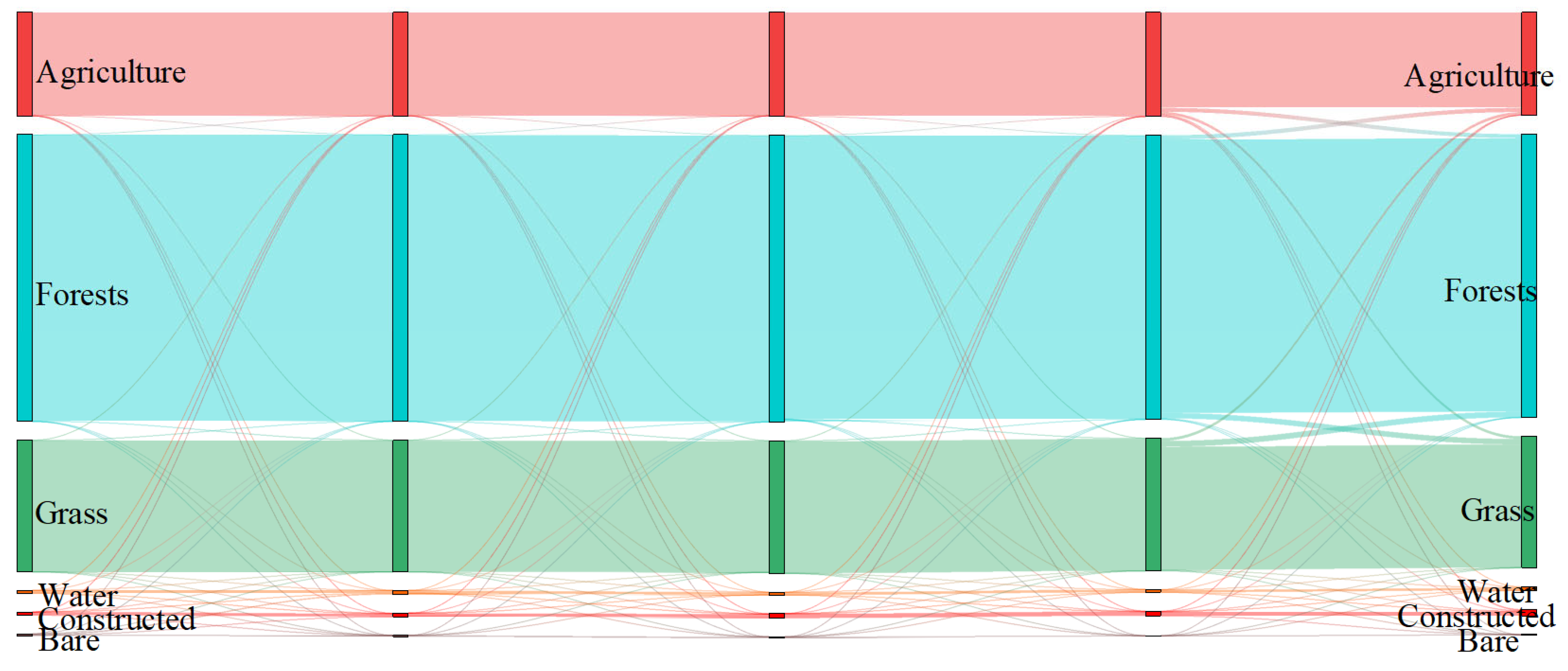
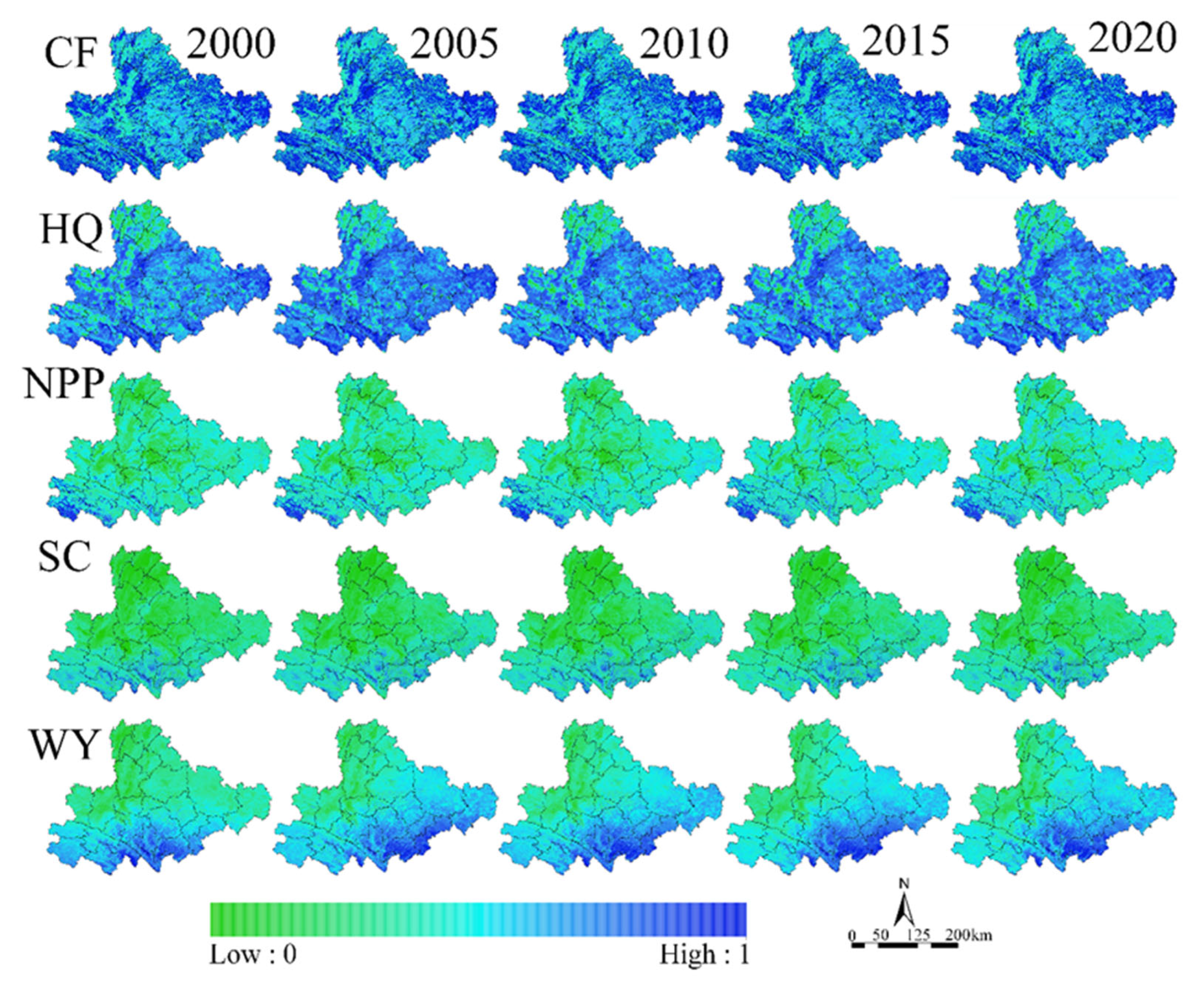
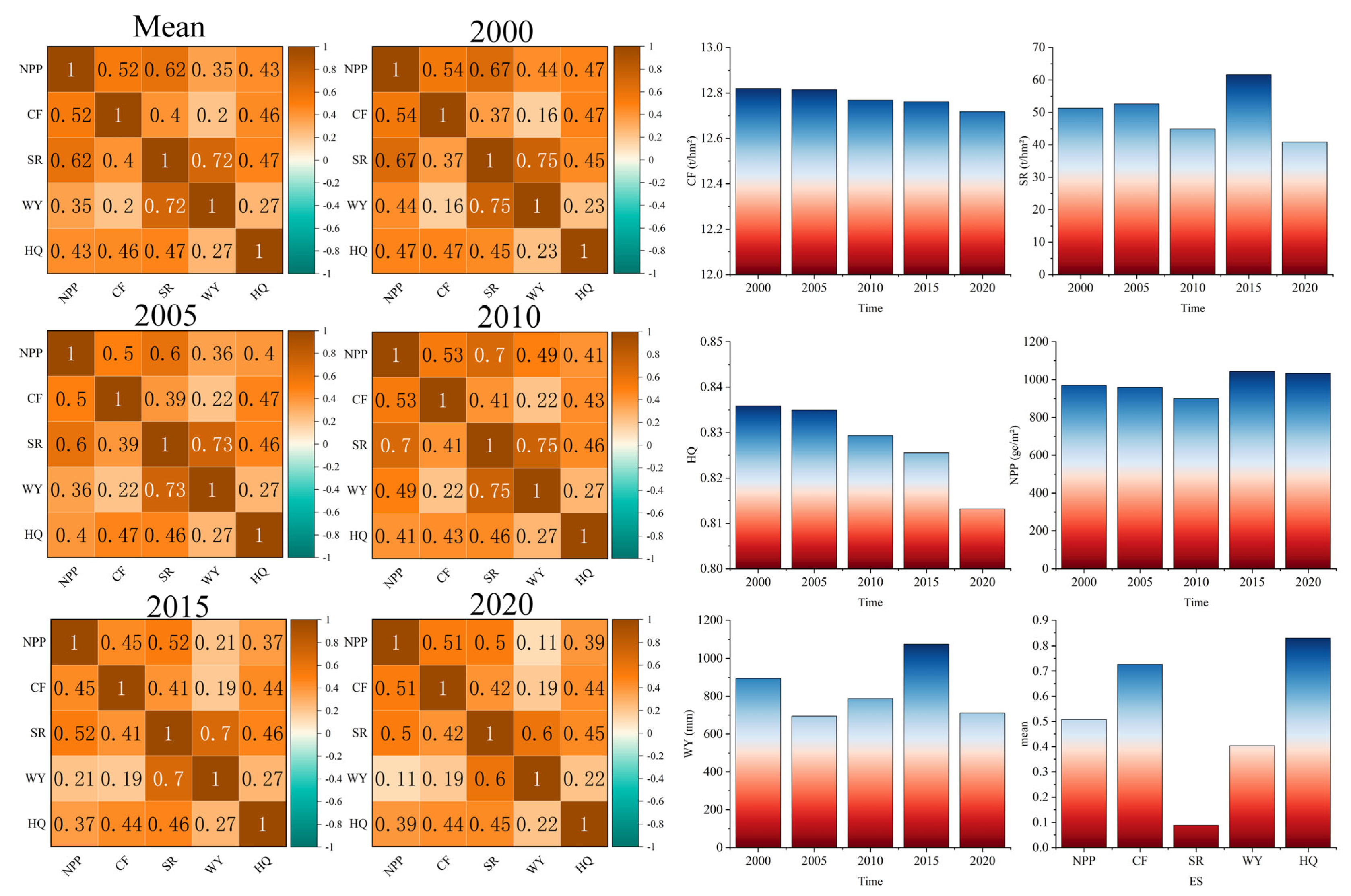
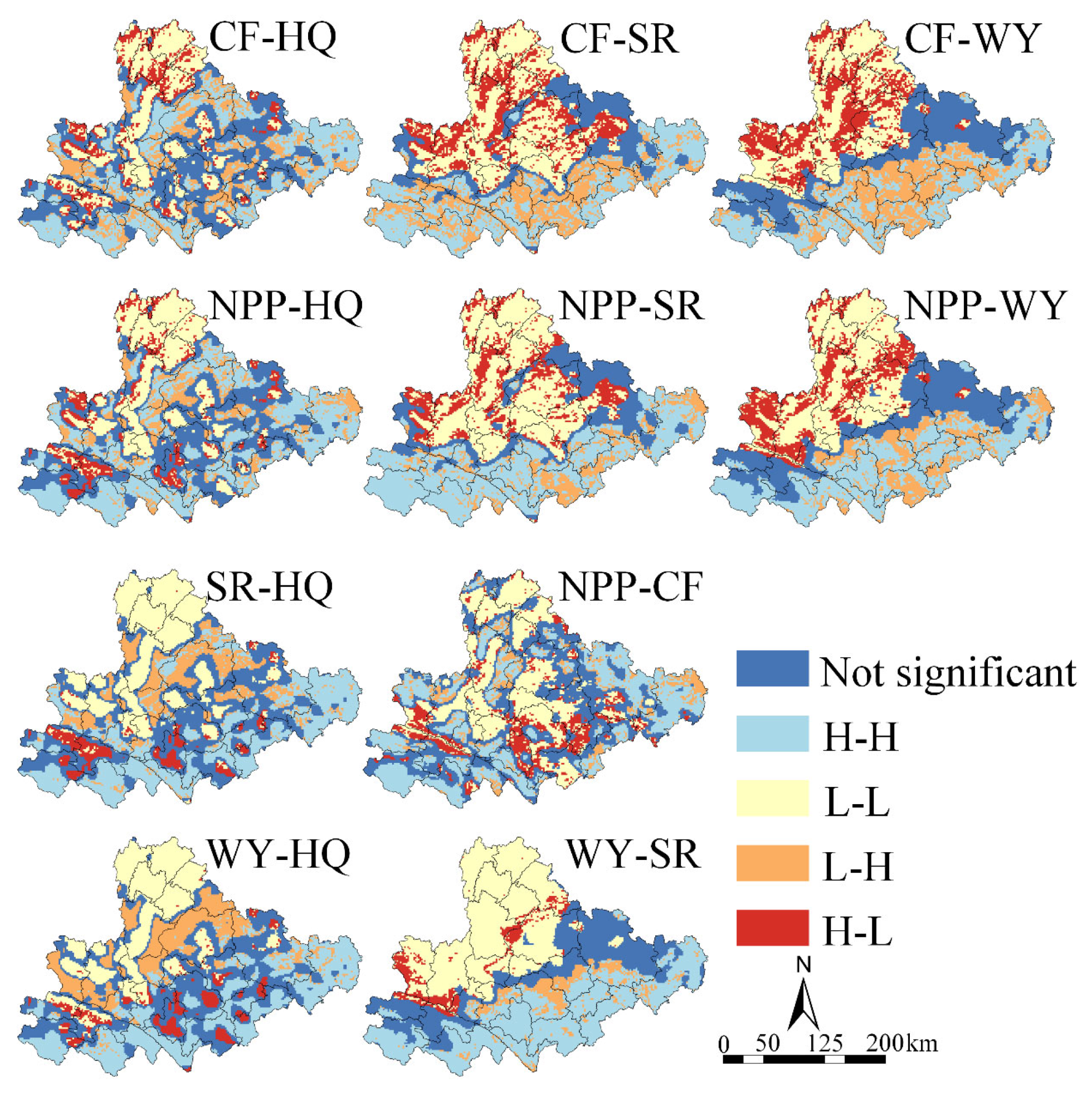
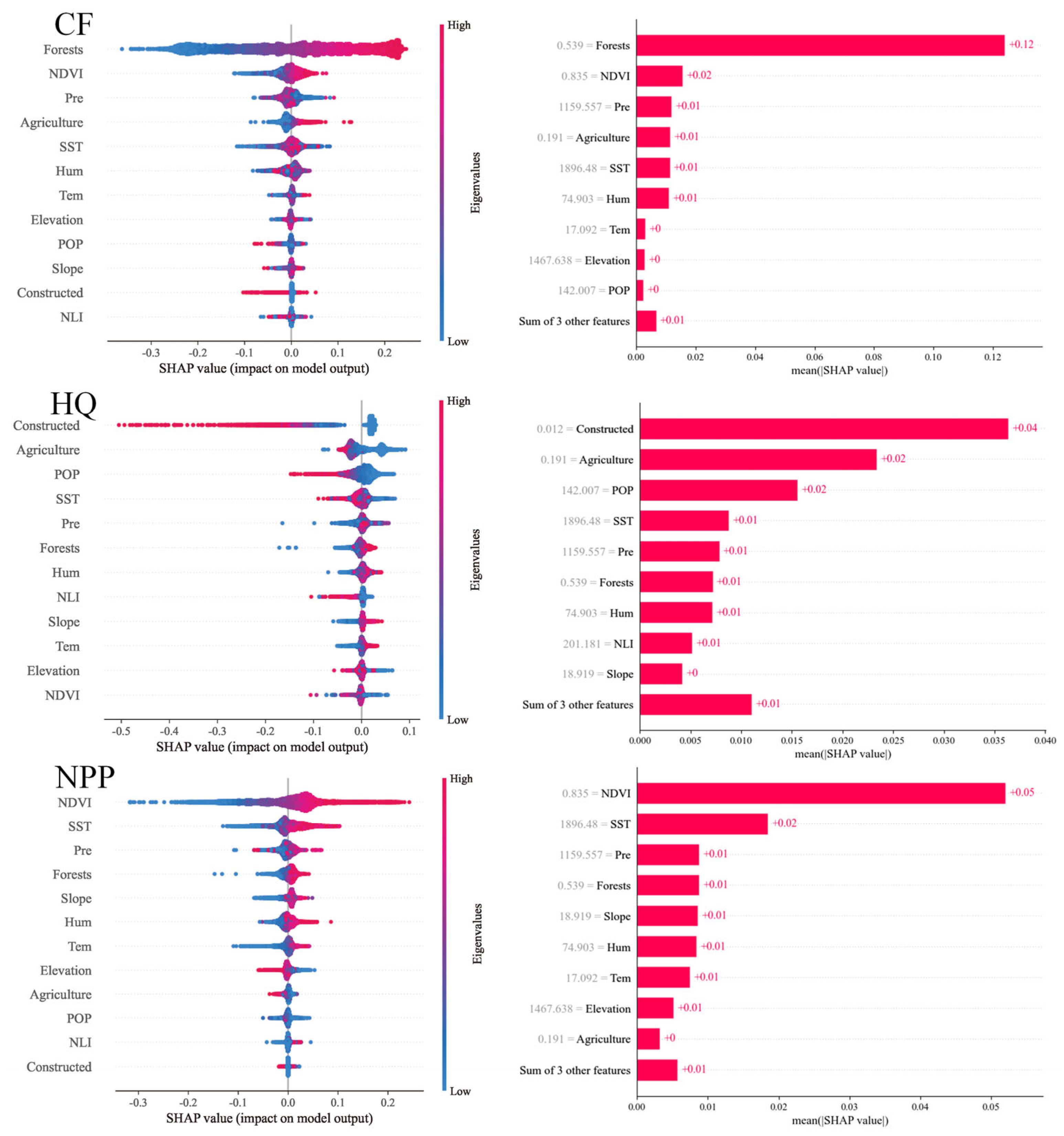

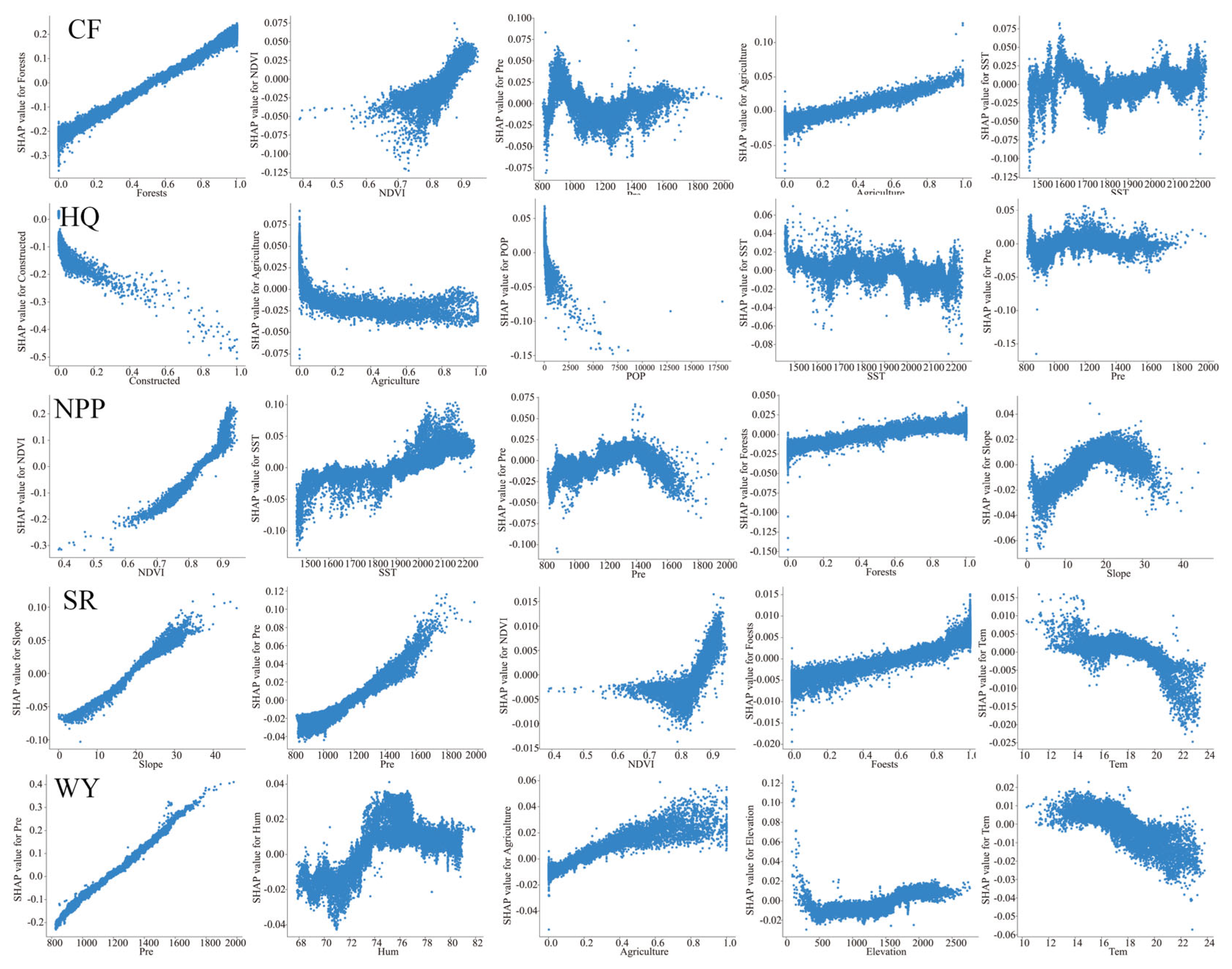
| Year 2000 | 2020 | |||||
|---|---|---|---|---|---|---|
| Arable Land | Woodland | Grassland | Body of Water | Building Site | Unused Land | |
| arable land | 1,241,494.56 | 69,164.28 | 57,641.85 | 6108.21 | 33,273 | 436.05 |
| woodland | 80,969.67 | 3,676,651.56 | 119,562.39 | 10,125.45 | 10,716.21 | 155.43 |
| grassland | 65,962.71 | 104,375.07 | 1,603,503 | 5095.17 | 11,563.11 | 77.85 |
| body of water | 3441.06 | 1422.81 | 1163.7 | 29,592.09 | 546.66 | 32.22 |
| building site | 5319.72 | 997.11 | 665.1 | 630.18 | 34,380.36 | 81.18 |
| unused land | 1944.72 | 1706.58 | 6975.72 | 86.94 | 15.48 | 6904.35 |
Disclaimer/Publisher’s Note: The statements, opinions and data contained in all publications are solely those of the individual author(s) and contributor(s) and not of MDPI and/or the editor(s). MDPI and/or the editor(s) disclaim responsibility for any injury to people or property resulting from any ideas, methods, instructions or products referred to in the content. |
© 2024 by the authors. Licensee MDPI, Basel, Switzerland. This article is an open access article distributed under the terms and conditions of the Creative Commons Attribution (CC BY) license (https://creativecommons.org/licenses/by/4.0/).
Share and Cite
Zhou, B.; Chen, G.; Yu, H.; Zhao, J.; Yin, Y. Revealing the Nonlinear Impact of Human Activities and Climate Change on Ecosystem Services in the Karst Region of Southeastern Yunnan Using the XGBoost–SHAP Model. Forests 2024, 15, 1420. https://doi.org/10.3390/f15081420
Zhou B, Chen G, Yu H, Zhao J, Yin Y. Revealing the Nonlinear Impact of Human Activities and Climate Change on Ecosystem Services in the Karst Region of Southeastern Yunnan Using the XGBoost–SHAP Model. Forests. 2024; 15(8):1420. https://doi.org/10.3390/f15081420
Chicago/Turabian StyleZhou, Bao, Guoping Chen, Haoran Yu, Junsan Zhao, and Ying Yin. 2024. "Revealing the Nonlinear Impact of Human Activities and Climate Change on Ecosystem Services in the Karst Region of Southeastern Yunnan Using the XGBoost–SHAP Model" Forests 15, no. 8: 1420. https://doi.org/10.3390/f15081420






